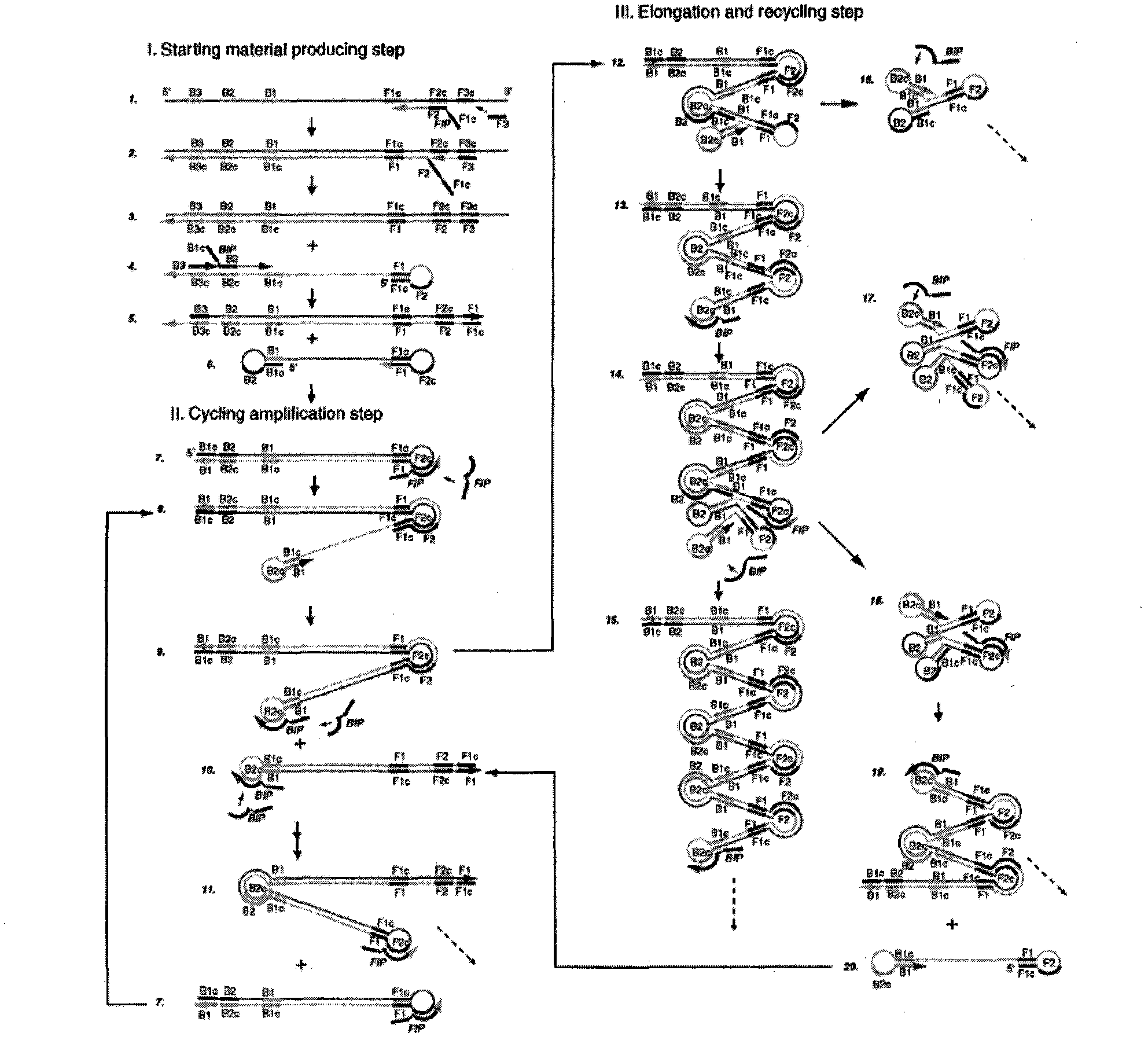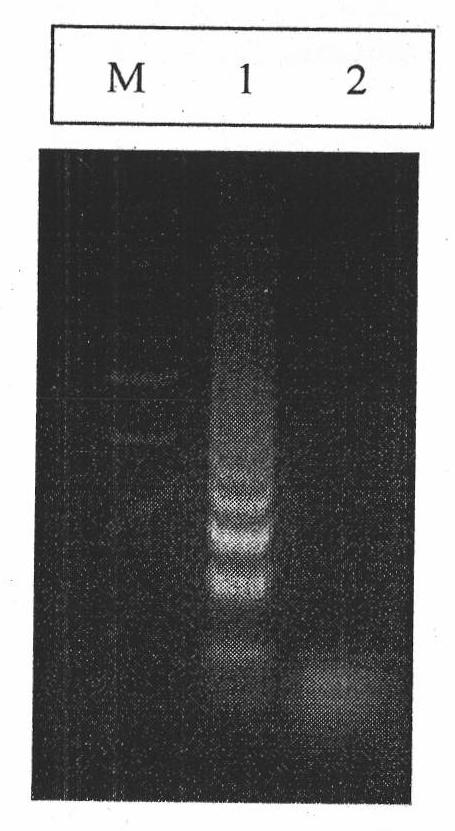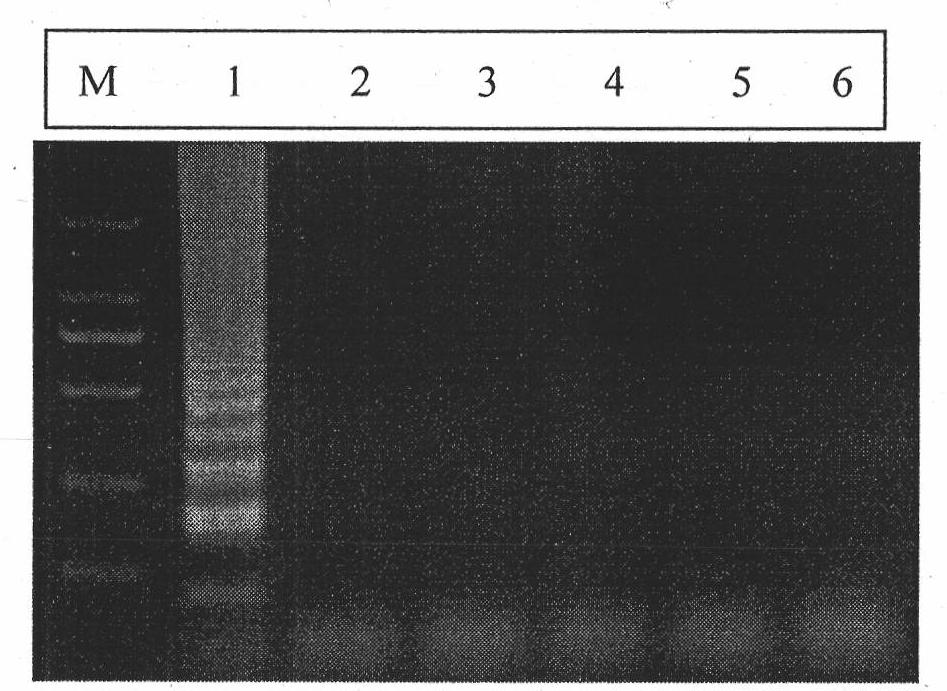Method for detecting swine epidemic diarrhea by reverse transcription-loop-mediated isothermal amplification
A porcine epidemic diarrhea, ring-mediated isothermal technology, applied in the field of molecular biology, can solve the problems of non-specific amplification, long amplification time, unfavorable promotion and application in grass-roots laboratories, etc. The effect of shortening the detection time
- Summary
- Abstract
- Description
- Claims
- Application Information
AI Technical Summary
Problems solved by technology
Method used
Image
Examples
Embodiment 1
[0032] Embodiment 1: A method for detecting porcine epidemic diarrhea by reverse transcription-loop-mediated isothermal amplification of the present invention, the steps are as follows:
[0033] Step 1: Design primers: According to the conserved region gene of PEDV N protein, design 3 pairs of primers targeting 6 regions (underlined parts) on the target gene: FIP, BIP, F3, B3, F-loop, B-loop; synthesized according to the literature Two RT-PCR primers (PED1, PED2), the primers were synthesized by Nanjing GenScript Biotechnology Co., Ltd., the template and primer sequences are as follows:
[0034] AATCCAGGGCCACTTCGA A GGAACGTGACCTCAAAAGACA TCCC
[0035] AGAGTGGAGGAGAATTCCCAA GGGCGAAAATAGCGTAGCAGCT
[0036] TGCTTC GGACCCAGAGGGGGCTTCAA AAACTTTGGAGATGCGG
[0037] AATTTGTCGAAAAAG GTGTTGATGCGTCAGGCT AT GCTCAGATC
[0038] GCCAGTTTAGC
[0039]
[0040] Step 2: Preparation of virus: Vero cells in good condition were inoculated in a 6-well plate, placed at 37°C, 5% CO...
Embodiment 2
[0051] Example 2: Combining figure 1 , a reverse transcription-circle-mediated isothermal amplification method for detecting porcine epidemic diarrhea according to the invention, 3 pairs of primers are designed for 6 regions on the target gene, which improves the specificity of the reaction and reduces the generation of non-specific reactions. Since the LAMP reaction is carried out under constant temperature conditions, the equipment is simple and only needs a water bath. The LAMP reaction does not require thermal denaturation to change the double-stranded DNA into a single strand like the PCR reaction, because the double-stranded DNA is in a state of dynamic equilibrium at about 65°C, and any primer and the complementary part of the double-stranded DNA perform base pairing extension. At that time, the other chain will fall off and become a single chain. The LAMP method utilizes this characteristic to carry out the reaction. It does not need to carry out multiple temperature...
Embodiment 3
[0052] Example 3: Technical principle: In 2000, Japanese scholar Notomi et al. invented a new method called loop-mediated isothermal amplification (LAMP). This method uses 4 (or 6) different specific primers to identify 6 specific regions of the target gene, and can perform amplification reactions under isothermal conditions. High amplification efficiency, can amplify 10 in 15-60min 9 ~10 10 times.
[0053] Primer design:
[0054] Three pairs of primers were designed based on 6 different sites including the F3c, F2c and F1c regions at the 3' end of the target gene and the B1, B2 and B3 regions at the 5' end. FIP primer: upstream internal primer, consisting of F2 region, F2 region is complementary to the F2c region at the 3' end of the target gene, and has the same sequence as the F1c region at the 5' end of the target gene. F3 Primer: An upstream external primer consisting of the F3 region and complementary to the F3c region of the target gene. BIP primer: downstream inte...
PUM
 Login to View More
Login to View More Abstract
Description
Claims
Application Information
 Login to View More
Login to View More - R&D
- Intellectual Property
- Life Sciences
- Materials
- Tech Scout
- Unparalleled Data Quality
- Higher Quality Content
- 60% Fewer Hallucinations
Browse by: Latest US Patents, China's latest patents, Technical Efficacy Thesaurus, Application Domain, Technology Topic, Popular Technical Reports.
© 2025 PatSnap. All rights reserved.Legal|Privacy policy|Modern Slavery Act Transparency Statement|Sitemap|About US| Contact US: help@patsnap.com



